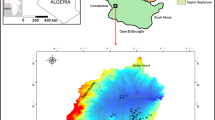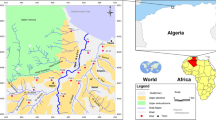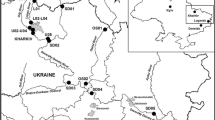Abstract
The lacustrine complex of El Kala (LCEK) is recognized for its biodiversity richness and its perennial water resources, which have allowed it to be included in the Ramsar List thanks to the ecological and scientific importance of its wetlands. The lacustrine complex has, therefore, been under protection against all harmful human activities for its preservation. However, the vicinity of the wetlands has been encroached in the last decades, as exemplified by increased socioeconomic activities at the expense of the lacustrine ecosystem. The objective of this work is to identify the degree of chemical contamination of waters and of pollution by organic bodies in relation to the resulting domestic discharges and to the use of fertilizers in agriculture. Therefore, four superficial and six groundwater samples were collected and analyzed in the laboratory for some major chemical and organic parameters, namely sodium, sulfates, chlorides, nitrates, biological oxygen demand, chemical oxygen demand, phosphates, total phosphorus, ammonium, and dissolved oxygen. The contamination index (CI) and the organic pollution index were determined. The CIs’ values for the majority of the samples were lower than 7, indicating a low chemical contamination of waters. The organic pollution index ranged from high (2.3) to very high (1.5–1.8), suggesting the waters are polluted by organic substances. Also, the waters in the LCEK are likely charged with organic bodies in high concentrations, which may cause a risk of pollution of an anthropogenic origin that will have a negative impact on the maintenance of the ecosystem.
Access provided by Autonomous University of Puebla. Download conference paper PDF
Similar content being viewed by others
Keywords
1 Introduction
Water is life (Cleland and CF 2002) because it guarantees the survival and the maintenance of the living species (Carl 1937), especially the perpetuity of the human being (Gleick 1996). Man needs a good water quality for drinking, irrigating crops, and stimulating the industry growth. He looks for the best places to get water in big quantities, including freshwater ecosystems (rivers, wetlands) (Postel and Richter 2003). Man enters his environment aggressively by destroying the flora, throwing his garbage which contains harmful substances, leading to the degradation of the water quality and biodiversity (Aras et al 2018). Many studies have approached the problem of water contamination by chemical, organic, and metallic bodies (Alfy 2012; Saadali et al 2015; Belabed et al. 2017; Boujghad et al 2019; Haouti et al 2018; Loucif et al. 2020) through the discharge of solid and liquid products depending on the increase in water demand due to population growth and accompanied socioeconomic activities.
The lacustrine complex of El Kala (LCEK) is located in the extreme northeast of Algeria, on the Algerian-Tunisian boundaries. The study area is formed by wetlands classified in the Ramsar List as Waterfowl Habitats: the lacustrine sites (Tonga, Oubeira, Mellah, and Blue Lake), the integral reserve of the Noir Lake peat bog, and the alder stands of Ain-Khiar. The LCEK is approximately within latitude 36°46'–36°55' N and longitude 08°11'–08°38' E (see Fig. 1).
According to the aridity index IDM (Martonne 1926), the study area is positioned in the semi-humid climate range, with an IDM equal to 27.29, from the data of El Kala climatic station (1971–2010), an average annual rainfall of 770.1 mm, and an average annual temperature of 18.22 °C. Inside the LCEK, hitherto devoid of any human implantation threatening its biodiversity, there were human infrastructures spreading in parallel with a continued demographic growth (see Fig. 2).
This has led to the degradation of wetlands by socioeconomic activities. In this work, we focused on the interpretation of the chemical and organic parameters of the water samples collected and analyzed in the laboratory to determine the appropriate pollution indices and assess the levels of water contamination in the LCEK waters.
2 Methods
A total of six (06) groundwater samples from hand-dug wells (W) and springs (S) and a total of four (04) superficial water samples from the watercourses (R) were collected during the month of July 2011 (see Fig. 2). The water samples were transferred to Fertial’s central laboratory for the determination of sodium (Na+), sulfates (SO42−), chlorides (Cl−), phosphates (PO43−), and total phosphorus (P2O5) concentrations. Biological oxygen demand for five days (BOD5), chemical oxygen demand (COD), nitrates (NO3−), and ammonium (NH4+) were determined at Horizon laboratory. The dissolved oxygen (O2) concentrations were determined at the laboratory of the Water and Sanitation Society of Annaba and El Tarf (SEATA).
The CI is calculated by attributing a number from 1 to 9 (classes) where the obtained concentrations of each of the four chemical parameters (Na+, SO42−, Cl−, and NO3−) are positioned (see Table 1); the sum of the obtained numbers corresponds to the value of CI. The highest value of CI exceeding the value 7 indicates that the water is very contaminated, and so, very polluted. The following equation is used to calculate the CI (Rouabhia et al 2004):
The method of the Institute of Hygiene and Epidemiology (IHE) is feasible by the availability of concentrations of BOD5, COD, NH4+, O2, PO43−, and P2O5. The principle is to position the obtained values of the six organic parameters according to the five classes (see Table 2). The average of the class numbers, obtained by the six parameters, gives the value of the IHE index which is represented according to five color classes (see Table 3) corresponding to the organic pollution levels (Saadali et al 2019).
3 Results and Discussion
3.1 Contamination Index (CI)
The CI values ranged between 3 and 14 with the majority of the samples (9 out of 10) having low CI (≤7). Only one sample of the well (W2), located at Oued El Hout, presents a high CI value of 14 (see Table 4). The high concentrations of chemical elements could be attributed to the presence of salt crystals in the subsoil and the nature of uncultivated soils rich in organic matter (Saadali 2016).
The waters are slightly contaminated and slightly polluted by these chemical elements (CI ≤ 7), whereas the water of the well (W2) is highly contaminated and highly polluted by these elements (CI > 7).
3.2 Organic Pollution Degree
The averages calculated of IHE indices are all below 2.9 (see Table 5). The IHE indices have a constant value of 2.3 for groundwater represented by the orange color, but vary between 1.5 and 1.8 for surface water represented by red color.
This indicates that the groundwater has high levels of organic pollutants, while the surface waters contain very high levels of organic pollutants, suggesting that the waters in LCEK are polluted by certain organic elements of anthropogenic source.
4 Conclusions
The purity of the LCEK has been affected by the irrational human intervention on the physical environment normally protected by the state considering its ecological importance. This is exemplified by the computed CI from the results of the chemical analysis conducted on both groundwater and superficial water samples collected from the area. The organic pollution index also indicated a high degree of pollution by organic substances resulting from anthropogenic activities. The consequences of the water quality deterioration could cause dysfunction in the lifestyle of living species. Our main aim of this study was to indicate the water pollution, from human origins, which is one of the main factors of environmental degradation. The findings may provide, to local and scientific communities, an overview of a possible deterioration of aquatic environments and a disruption of the ecological balance that can, in future, affect this sensitive and presumably protected area, by increasing anthropogenic activities and water pollution.
References
Aras, K., Omed, M., Broder, M.: Geochemical and environmental investigation of the water resources of the Tanjero area, Kurdistan region, Iraq. Arab. J. Geosci. 11, 461 (2018). https://doi.org/10.1007/s12517-018-3825-7
Belabed, B.E., Meddour, A., Samraoui, B., Chenchouni, H.: Modeling seasonal and spatial contamination of surface waters and upper sediments with trace metal elements across industrialized urban areas of the Seybouse watershed in North Africa. Environ. Monit. Assess. 189(6), 265 (2017). https://doi.org/10.1007/s10661-017-5968-5
Boujghad, A., Bouabdli, A., Baghdad, B.: Groundwater quality evaluation in the vicinity of the Draa Sfar Mine in Marrakesh, Morocco. Euro-Mediterr. J. Environ. Integr. 4, 12 (2019). https://doi.org/10.1007/s41207-018-0096-3
Carl, G.C.: Flora and fauna of brackish water. Ecol 18(3), 446–453 (1937). https://doi.org/10.2307/1930619
Cleland, C.E., Chyba, C.F.: Defining ‘Life’. Orig. Life Evol. Biosph. 32, 387–393 (2002). https://doi.org/10.1023/A:1020503324273
El Alfy, M.: Integrated geostatistics and GIS techniques for assessing groundwater contamination in Al Arish area, Sinai, Egypt. Arab. J. Geosci. 5(2), 197–215 (2012). https://doi.org/10.1007/s12517-010-0153-y
El Haouti, R., Anfar, Z., Et-Taleb, S., Benafqir, M., Lhanafi, S.E., Alem, N.: Removal of heavy metals and organic pollutants by a sand rich in iron oxide. Euro-Mediterr. J. Environ. Integr. 3, 17 (2018). https://doi.org/10.1007/s41207-018-0058-9
Gleick, P.H.: Basic water requirements for human activities: meeting basic needs. Water Int 21(2), 83–92 (1996). https://doi.org/10.1080/02508069608686494
De Martonne, E.: L'indice d'aridité. Bulletin de l'Association de géographes français (9), pp. 3–8, Paris (1926)
Loucif, K., Neffar, S., Menasria, T., Maazi, M.C., Houhamdi, M., Chenchouni, H.: Physico-chemical and bacteriological quality assessment of surface water at Lake Tonga in Algeria. Environ. Nanotechnol. Monit. Manag. 13, 100284 (2020). https://doi.org/10.1016/j.enmm.2020.100284
Postel, S., Richter, B.: Rivers for Life: Managing Water for People and Nature. Island Press, Washington, DC (2003)
Rouabhia, A., Baali, F., Kherici, N., Djabri, L.: Vulnérabilité et risque de pollution des eaux souterraines de la nappe des sables miocènes de la plaine d’El MA EL Abiod (Algérie). Sécheresse 15(4), 347–352 (2004)
Saadali, B.: Impact de l’activité anthropique sur la dégradation de la qualité des eaux et de l’environnement : Cas du Parc National d’El Kala (Nord-Est algérien). Doctoral thesis. Annaba University (2016)
Saadali, B., Derradji, EF., Saboua, T., Remita, R., Zahi, F.: Impact of the anthropogenic activity on the degradation of the environment and water’s quality: El Kala National Park (North East of Algeria). Rev. Sci. Technol. Synthèse 30, 66–75 (2015)
Saadali, B., Mihoubi, N., Ouddah, A., Bouroubi, B.: Organic pollutants evolution and degrees of contamination of Hammam Grouz dam waters, North-East of Algeria. In: Chaminé, HI., Barbieri, M., Kisi, O., Chen, M., Merkel, BJ. (eds.) Advances in Sustainable and Environmental Hydrology, Hydrogeology, Hydrochemistry and Water Resources 2018, Advances in Science, Technology & Innovation, vol. 1, pp. 145–148. Springer Nature, Switzerland (2019). https://doi.org/10.1007/978-3-030-01572-5_36
Author information
Authors and Affiliations
Corresponding author
Editor information
Editors and Affiliations
Rights and permissions
Copyright information
© 2022 The Author(s), under exclusive license to Springer Nature Switzerland AG
About this paper
Cite this paper
Saadali, B., Derradji, E.F., Zerrouki, H., Bougherira, N., Bahroun, S., Khiari, A. (2022). Chemical and Organic Contamination Degree of Waters in the Lacustrine Complex of El Kala (Northeastern Algeria). In: Chenchouni, H., et al. New Prospects in Environmental Geosciences and Hydrogeosciences. CAJG 2019. Advances in Science, Technology & Innovation. Springer, Cham. https://doi.org/10.1007/978-3-030-72543-3_129
Download citation
DOI: https://doi.org/10.1007/978-3-030-72543-3_129
Published:
Publisher Name: Springer, Cham
Print ISBN: 978-3-030-72542-6
Online ISBN: 978-3-030-72543-3
eBook Packages: Earth and Environmental ScienceEarth and Environmental Science (R0)






